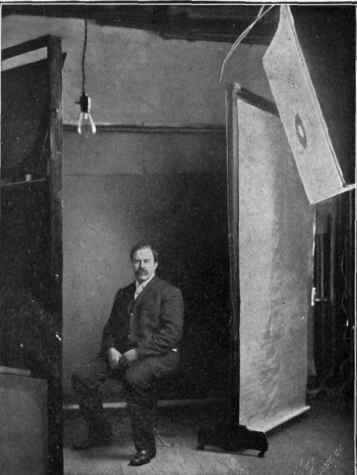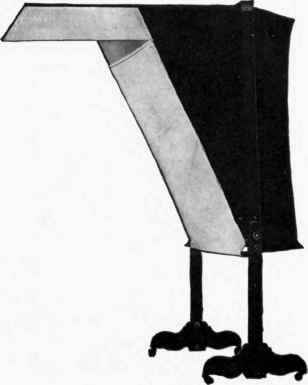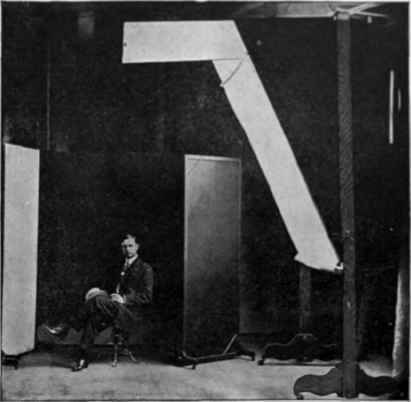Portraiture With The Aristo Lamp. Continued
Description
This section is from the book "Complete Self-Instructing Library Of Practical Photography", by J. B. Schriever. Also available from Amazon: Complete Self-Instructing Library Of Practical Photography.
Portraiture With The Aristo Lamp. Continued
560. The "spot light," which emphasizes the catch-lights on the high parts of the face, is made by taking four or six-ply cardboard, fourteen inches in diameter, and cutting a hole in the center two inches in diameter. Make a circular line ten inches in diameter. With a sharp knife cut points from the line to the outer edge of the card. Make these points about an inch wide at the base, and have them fringe the entire circumference of the card. Cut a couple of slots in the card above and below the center opening. Run through these lines a piece of white cord long enough to reach from the bottom to top of hood. Attach a wire hook to each end of this cord, which is to be fastened over the top frame and under the bottom frame thus holding the "spot light" flat and close to the tracing cloth.

Illustration No. 72 Hood for Aristo Lamp See Paragraph No. 559.

Illustration No. 73. Spot-Light on Head Screen.
See Paragraph No. 563.

PORTRAIT STUDY Study No. 24-See Page 579, Vol. VIII Curtis Bell.
561. This "spot light" not only emphasizes the highlights of the face, but it also diffuses the light without interfering with the speed. It is to be raised or lowered on this string, or moved from side to side, until the center opening comes exactly in line between the arc of the lamp and the face of the sitter.

Illustration No. 74. Diagram of Frame for Aristo Lamp.
See Paragraph No. 563.
562. In Illustration No. 72 is shown a screen which was placed on a line with the back of the sitter to shield the background from light. The only other accessory used was a reflector on the shadow side of subject, as shown in the illustration.
563. In the method just described, the lamp is hung from the ceiling. It is considered by many an improvement to attach the lamp to a movable standard, with a "spot llight" placed on a head screen between the hood and the sitter, as shown in Illustration No. 73. This is done by constructing a frame made of 2 x 3 material, nine feet high and four feet and one-eight inch between the uprights. The lamp is hung by a large hook from the top bar. (See Illustration No. 74.)
564. The screen is made of ordinary stretchers, forty-eight inches square, hinged together to form a triangle, covered on the front with tracing linen, the other two sides with white muslin, on the inside for reflector, and black opaque cloth on the outside. The bottom is also covered with opaque material. The top is left open. The triangular frame is hung to the uprights about eight inches from the top by pin hangers at the bottom, and can be tilted to an angle of about forty-five degrees by a cord running from the top at the back over a small pulley on the top bar and down the sides of the frame, so that it can be easily adjusted to an angle. (See Illustration No. 74.) The diffusing screen is made by using an ordinary head screen covered with blue cheese cloth, with a "spot light " fastened to it by fine wire. The side screen is also used for white draperies. By a little practice with the screen, one can obtain perfect control of the light.

Illustration No. 74a. Aristo Lighting Cabinet Showing Position of Lamp..
See Paragraph No. 564.c.

Illustration No. 74b. Aristo Lighting Cabinet. See Paragraph No. 564c..

Illustration No. 74c. Lighting Cabinet Folded for Storage or Shipment..
See Paragraph No. 564c.

Illustration No. 74d. Aristo Lamp in Use in Studio..
See Paragraph No. 564h.
METHOD OF USING THE ARISTO LAMP
564-a. The following method of using the Aristo Lamp is the result of numerous experiments on the part of the company's own demonstrators of the lamp under all sorts of conditions.
564-b The cabinet illustrated herein is built collapsible as will be observed, making it convenient for shipment. For ordinary studio requirements it may be much simplified in construction, as compact folding will be unnecessary.
564-c. Illustration No. 74a shows the cabinet with the lamp in the correct position, and with the light diffusing curtain rolled down to afford a clear idea of the construction. Illustration No. 74b hows the cabinet when assembled for use. Illustration No. 74c shows the cabinet folded for storage or shipment.
564-d. The total height of the cabinet when erected is 10 ft., the hood being 7 ft. high, and placed 3 ft. from the floor. The tops of the triangular side pieces are 3 ft. in length and support the top screen, which is 6 ft. square, the top screen projecting 3 ft. in front of the diffusing screen. The supporting bases have a spread of 3 ft., which renders the cabinet perfectly steady, and being fitted with the regular stand castors, it may be readily moved to any desired point.
564-e The lamp is not attached to the cabinet, but merely suspended inside of it, being supported from the ceiling or side wall of the studio in the ordinary manner.
564-f. The cabinet is covered on the inside with bleached muslin, painted a light blue with alabastine paint, which may be easily applied with the ordinary paint brush. The outside of the cabinet is covered with brown denim, stretched over the frames, and secured in place by means of tacks. The front screen, through which light passes, is made of lonsdale cambric, and for ordinary use may be tacked directly to the frame, instead of fastened to a spring roller, as shown in the illustration.
564-g. It is, perhaps, needless to state that the diffusing screen must be kept clean and free from wrinkles.
564-h In Illustration No. 74d is shown the cabinet in use in the studio, with background, reflectors and subject in position, and affords an excellent idea of its proportions and how the light may be controlled.
Continue to:


